I have always been fascinated by streets that dramatically change character from one end to the other, as well as change their level of traffic. There are a number of streets in NYC that start with just a trickle of traffic and build and build to a heavy volume, such as Staten Island’s Hylan Boulevard, which begins quietly at the Alice Austen House (which belonged to the famed late 19th-early 20th Century photographer) on the Narrows, becomes a screaming, honking mess as it roars down the island’s east shore, and ends quietly again at the historic Billopp Conference House, where Ben Franklin unsuccessfully tried to stave off the Revolutionary War.
Each borough except Manhattan has a street, or streets, named Union, and Manhattan has the bustling Union Square, named for the confluence of Broadway (earlier Bloomingdale Road) and the Bowery. Brooklyn’s Union Street is named for the Union Stores, an 1800s East River dockside repository for sugar, molasses and other comestibles. Both Brooklyn and the Bronx’ Union Avenue are likely named for the Union Army following the Civil War.
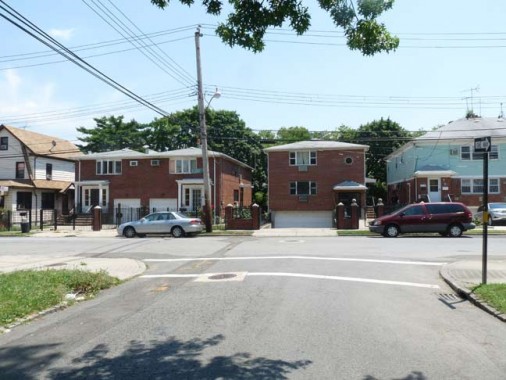
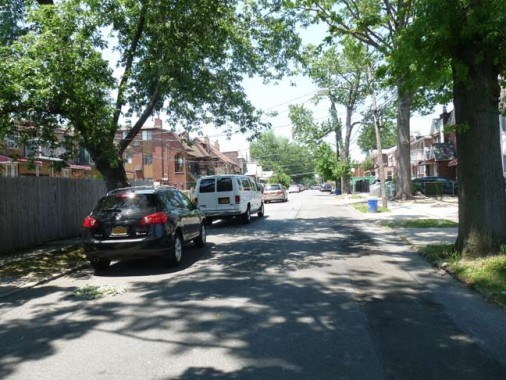
I worked my way from south to north along Union Street, from its tamest point to its busiest. The street begins at Negundo Avenue, in the section of Flushing named for plants in alphabetical order from A to R. Flushing, beginning in the colonial era and for almost 200 years, was home to a number of plant nurseries where people would come from all over the NYC area to buy flowering plants and fruit trees. That era ended in the early 20th Century when Flushing became increasingly urbanized.
Union Street ends here at Negundo Avenue; negundo is a species of maple tree also known as the box elder and maple ash.
A selection of the houses along southern Union Street. Older frame houses, likely from the 1920s and 30s, mix with newer Tudor -style buildings and even newer lawnless brick houses.
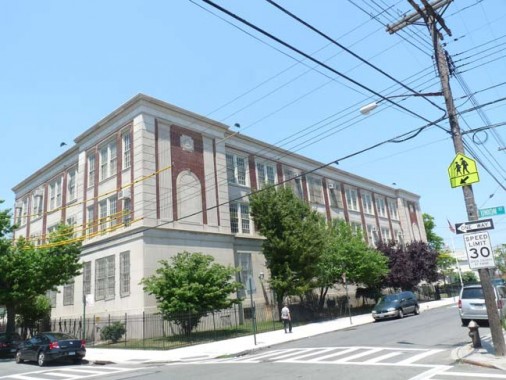
PS24 (the Andrew Jackson School), at Holly Avenue and Union Street. Like most NYC public schools, there’s no architectural information provided on the school’s website, but I did find a photo album of the school and the immediate area that was taken in 1979.
As can be seen on this google map excerpt, there is a three-block break in Union Street between Cherry and Franklin Avenues. There’s a reason for it that’s over a century old.
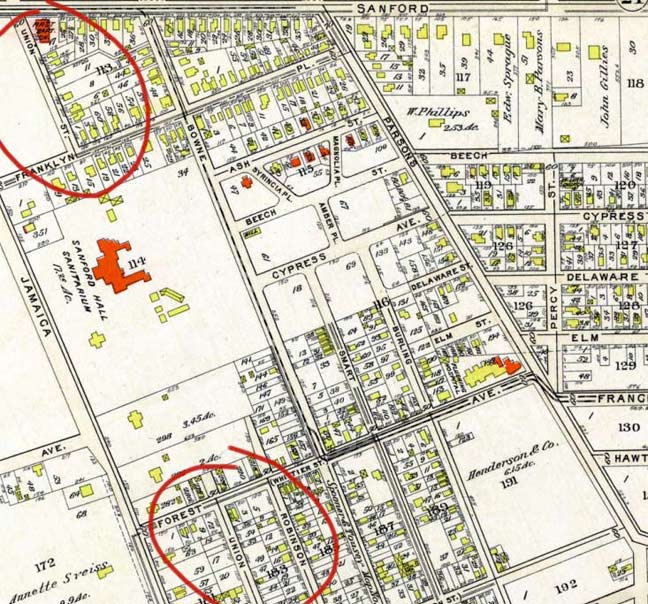
On this 1909 atlas plate I have circled the two pieces of Union Street, which remain separated. The space between them was once occupied in large part by the Sanford Hall Sanitarium, which fronted on Jamaica Road (now Kissena Boulevard). What was the first private asylum in NY state was established in 1841 by Dr. James McDonald. One of its more famed patients was actress Georgia Cayvan; she died there at age 49.
Cayvan was famed for wearing a glass dress.
The sanitarium closed in the first half of the 20th Century (certainly by the early 1920s); Ash, Beech and Cherry Avenues, and their private houses, now take its place.

On Union between Franklin and Sanford, Sanford Towers, a large, multi-unit apartment building that I guess goes back to the late 1920s or early 20s, stands in contrast to the cheaper stuff that has infiltrated the neighborhood since the 1970s. Like many complexes of its type, it has a parklike center courtyard.
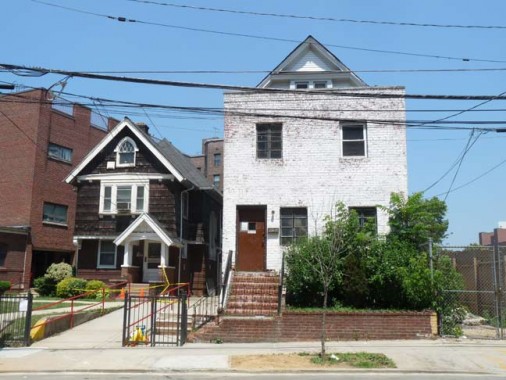
Two older buildings on the same block, the one on the left is the parish house of the First Baptist Church (see below). On the right, a boxy brick addition was made to the original wood frame house.
FIRST BAPTIST CHURCH (1890), SE corner Sanford Avenue and Union Street. First Baptist, perhaps, inherited the title of Flushing’s tallest church steeple after the one on St. George’s Episcopal on Main Street ws blown down in a September 16, 2010 tornado.
It’s the first of a number of churches to be encountered when walking north on Union Street.

First Baptist welcomes worshippers of many languages, only a couple of which I recognize. I think three are English, Hebrew, Arabic, and what else?
ST. MICHAEL’S ROMAN CATHOLIC CHURCH, NW corner of Union Street and Barclay Avenue. The original was built in 1854, matching it in age with St George Episcopal. It was on Union Street and 41st Avenue, closer to Long Island Rail Road tracks, which may have caused it to weaken. It finally had to be torn down and replaced by this modern building in 1961. The parish parochial school, built in the 19-teens, still stands close by on 41st Avenue.
The new church features the little-known symbols of the New Testament’s Twelve Apostles surrounding the front entrance, with the archangel Michael in the center. From top left, running counterclockwise:
Simon (a fish and a book; the apostles were ‘fishers of men’ through the Gospel)
Jude (a ship, to represent his missionary journeys across bodies of water)
John (a cup holding a snake; according to legend, John once blessed a cup of poisoned wine he was given to drink at a feast in Ephesus, and the poison departed the cup in the form of a snake)
Thomas (a carpenter’s square and spear; he supposedly built a church by himself in India, while he was martyred with a spear)
Matthew (three bags of money; his first career was as a tax collector)
Peter (two crossed keys; as the first leader of the Church, Peter was given the authority of the Church or “keys to the kingdom”)
James the Less (Often represented by a saw, or in other representations, a fuller’s pole. Though tradition holds he was martyred by stoning, another story says he was clubbed in the head by a fuller’s pole, formerly used in cloth manufacturing)
Philip ( a cross and two loaves of bread, perhaps reminiscent of the Miracle of Loaves and Fishes)
Bartholomew (Tradition holds he was martyred in Armenia by being flayed, or having his skin cut off, while alive. His symbol is a knife accompanied by a book symbolizing the gospel)
James the Greater (three seashells symbolizing the coast of Spain, where he preached)
Andrew (fish on an X-shaped cross; he was supposedly martyred on one. The fish is a symbol of Christ, from its Greek name, ichthys, which contains an anagram, in Greek, of honorifics given to Jesus, explained on this page.)
Matthias (he was chosen after Judas Iscariot’s betrayal; his means of martyrdom was murder by ax)

An ancient fire alarm, probably from the 19-teens, at Barclay and Union Street. It still has the top shaft on which the alarm light was likely mounted that now serves to conduit electric wiring. The additions of police and fire call buttons was done in the 1980s.

We’ll see more of these later, but at about this point Union Street’s buildings begin to fill with signs mainly in the Chinese and Korean languages.
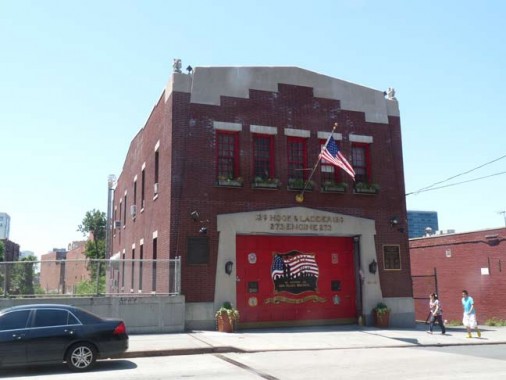
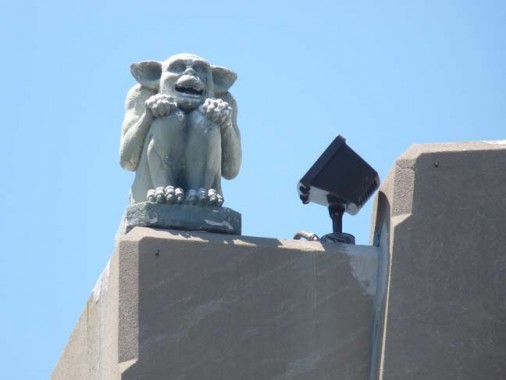
Engine 273/Ladder 129, built right by the tracks, has a pair of goblins on the roofline. There is also a firehouse built on Murray Street one stop east on the Port Washington branch LIRR line.
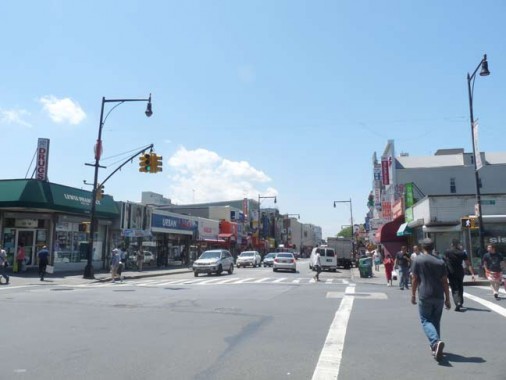
Shown is Roosevelt Avenue as it crosses Union Street. Roosevelt Avenue is an extension of Greenpoint Avenue at its junction with Queens Boulevard, running east under the el and beyond it to Northern Boulevard and 155th Street in Murray Hill. It was built at the same time the el was, opening in 1917.
Roosevelt Avenue joins Northern Boulevard and Jewel Avenue as the only local streets allowed to cross Flushing Meadows-Corona Park. East of the park, it took over the old route of Amity Street (with a few years’ stint as 40th Avenue) in 1928, when the el was extended as a subway to Main Street.
Nancy Reagan as a child lived on Amity Street (she was apparently borin in Sloane Hospital in Flushing, about which I know nothing), though for the most part she grew up in Chicago after her parents’ divorce and mother’s remarriage to a neurosurgeon, and moved on to Hollywood in 1949 as the silver screen beckoned.
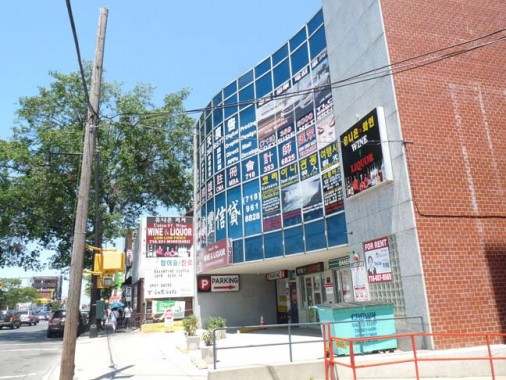
The glass front on this building, Union Street and 39th Avenue, was considered a dandy place to affix dozens of signs.
MACEDONIA AFRICAN METHODIST EPISCOPAL CHURCH, Union Street and 38th Avenue. This is the third oldest religious institution in Flushing; it was founded in 1811 as the African Methodist Society, welcoming a diverse congregation of blacks, whites and Native Americans. The previous church on the site was constructed in 1837 (and is represented on the sidewalk historic signage) — it may have been a stop on the Underground Railroad in teh 1850s and 1860s. This, the second building on the site, was dedicated in 1932.
While African-Americans were being pushed uptown in Manhattan the late 1800s and early 1900s, African-Americans were being removed altogether from the downtown Flushing area in the mid- to late-1940s. The officials of government identified their community as a slum and proceeded to implement a plan designed by Commisioner of Parks, Robert Moses, to build a parking lot and bus station. Not only homes, but the little red schoolhouse built in 1861 by the Flushing Female Association, despite its landmark status, fell to the wrecking balls. The new arrivals to the suburbs needed convenient parking for their shopping expeditions so a viable community was displaced for a parking lot. A way of life was destroyed as members of the African-American community were scattered, leaving only their church as a reminder of their former existence in the area.
The church was determined to maintain its presence on the original site, and with the help of the newly assigned pastor, the Rev. G. Grant Crumpley, this was accomplished despite overwhelming odds. Rev. Crumpley was able to acquire from the City the adjacent lot and the church proceeded to build the Youth Building complete with chapel. Surrounded by a city parking lot, Macedonia continues to stand in downtown Flushing on or near the original parcel of land purchased by “Trustees and members” in 1811. NYC American Guild of Organists
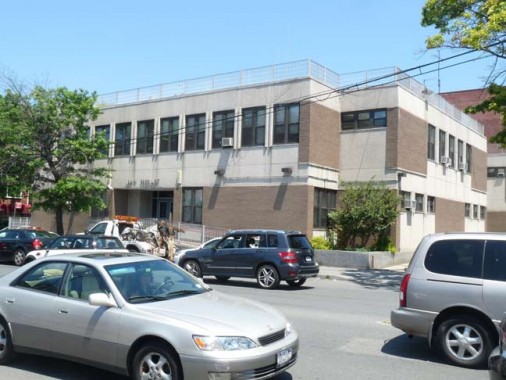
NYPD 109th Precinct, Union Street across from Macedonian AME.
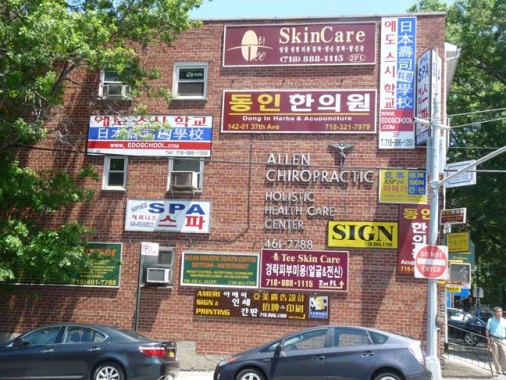
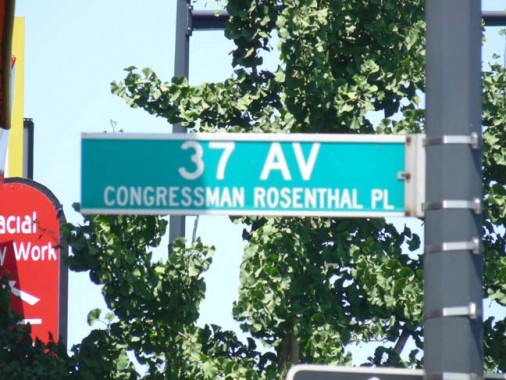
Beginning at 37th Avenue, building signage really tales over as every flat surface on the buildings lining Union Street are filled with an advertisement of some sort.
Since 1983 37th Avenue street signs have borne the subtitle ‘Congressman Rosenthal Place’ which should be replaced, as the practice since 1983 has been to post a separate sign bearing the nonoree’s full name.
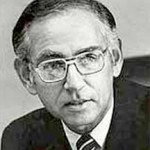 Benjamin Stanley Rosenthal (June 8, 1923 – January 4, 1983), a Representative from New York, was born in New York City. He attended public schools (including Stuyvesant High School), Long Island University, and City College. He served in the United States Army, 1943–1946, and received his LL.B. from Brooklyn Law School as well as an LL.M. from New York University, 1952. He was admitted to the New York bar in 1949 and commenced practice in New York City. He was elected as a Democrat to the Eighty-seventh United States Congress, by special election, to fill the vacancy caused by the resignation of United States Representative Lester Holtzman, and reelected to the eleven succeeding Congresses (February 20, 1962 – January 4, 1983). He died in Washington, D.C. wikipedia
Benjamin Stanley Rosenthal (June 8, 1923 – January 4, 1983), a Representative from New York, was born in New York City. He attended public schools (including Stuyvesant High School), Long Island University, and City College. He served in the United States Army, 1943–1946, and received his LL.B. from Brooklyn Law School as well as an LL.M. from New York University, 1952. He was admitted to the New York bar in 1949 and commenced practice in New York City. He was elected as a Democrat to the Eighty-seventh United States Congress, by special election, to fill the vacancy caused by the resignation of United States Representative Lester Holtzman, and reelected to the eleven succeeding Congresses (February 20, 1962 – January 4, 1983). He died in Washington, D.C. wikipedia
He was succeeded by US Rep. Gary Ackerman, who announced his plans for retirement at the end of his term on 1/2/2013.
Between 37th Avenue and north of Northern Boulevard, Union Street is absolutely awash with ads mounted on buildings, most of them in Korean and Chinese. Periodically there has been a push to feature English as prominently, but that is not likely to happen.
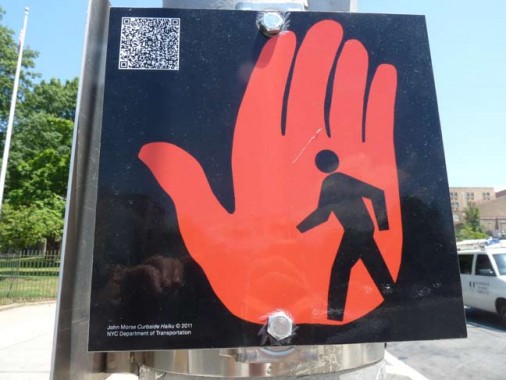
Signs warning pedestrians and bicycles to exercise care have sprung up (many written using haiku) along Northern Boulevard and elsewhere. This one is decipherable only if you point a smartphone at it.
Possibly Flushing’s most beautiful building, the Collegiate Gothic FLUSHING HIGH SCHOOL [C.B. J. Snyder, arch.], on the northeast corner of Northern Boulevard and Union Street, was completed here in 1915 on what had been the southern edge of the Parsons plant nursery. Flushing High was established in 1875, when Flushing was a separate town in the county of Queens, which was then more than twice its current size (it included most of what has been Nassau county since 1898). It first graduating class in 1878 had six students; today, there are over 2000 graduates per year.
The school’s monumental square entrance towers, picturesque silhouette, asymmetrical massing, and assorted Gothic-inspired details — crenellation, grotesque corbels, and heraldic statues of unicorns and griffins — echo the fanciful conjoining of styles typical of english universities. The Landmarks of New York III, Barbaralee Diamonstein, Harry N. Abrams 1998
The 1915 building was declared a New York City Landmark in 1991. Amazingly the school was going to be closed and reopened under a new name, with a new staff, after the 2012 school year because of a declining graduation rate, but after a United Federation of Teachers union lawsuit, the school will reopen in the fall of 2012… for now.
Some scenes from inside the school can be seen on this webpage.
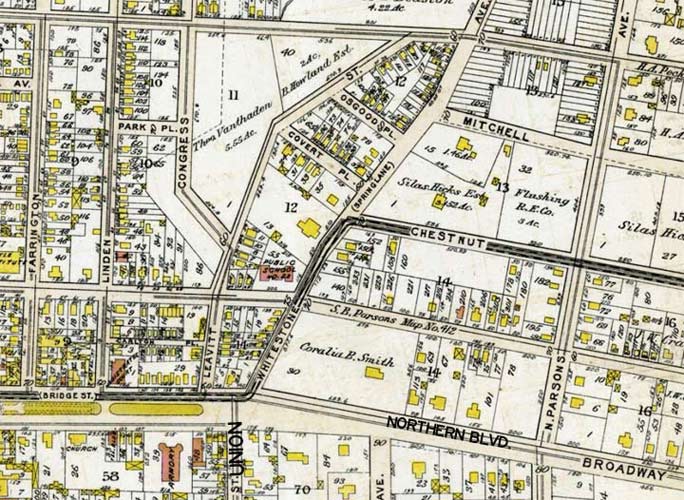
Union Street takes a jog to the northeast, and changes character again, after crossing Northern Boulevard. Originally this part of Union Street used to bear the name Whitestone Avenue, as shown on this 1909 atlas plate (I added a couple of contemporary names). Though this map also gives it the subtitle Spring Lane, others give that name to Leavitt Street a block to the west. (Leavitt is one of the few streets on the 1909 map that has kept its old name). Leavitt, with its twists and tuns, probably does follow a former spring.
Whitestone Avenue probably became Union Street when many other area streets were assigned numbers, and the whole house numbering scheme was changed. However, Flushing has kept a generous portion of its names, especially the ones associated with the area’s former role in the commercial plant business, than other parts of Queens.
You wonder, why bother extending Union Street along Whitestone Avenue’s old path, but that’s an over 80-year-old story now, and the issue has been decided.
More modest, but comparable in age, to Flushing High is the former PS23 (THE LINCOLN SCHOOL) on the NW corner of 25th Avenue and Union Street. Built in the 1890s, it’s the only survivor of the Lincoln, Washington, Jackson and Jefferson school buildings in Flushing, and is the only pre-consolidation (1898) school still standing. It is at present the Queens Academy High School.
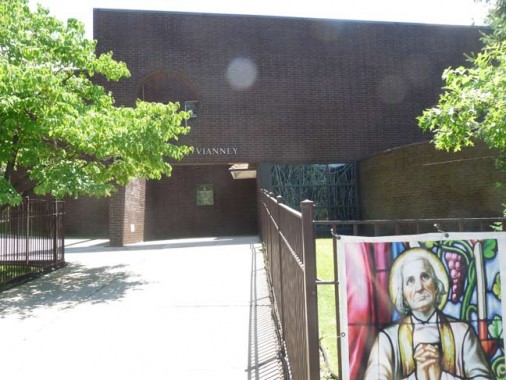
ST. JOHN VIANNEY ROMAN CATHOLIC CHURCH, 34th Avenue and Union Street.
On June 6, 1967, Archbishop Bryan J. McEntegart, the Bishop of Brooklyn, established the Parish of St. John Vianney. It was carved out of sections of the larger neighboring parishes of St. Michael, St. Mel and St. Andrew Avellino. The Brooklyn Diocese purchased the property on Union Street between 34th and 35th Avenues at a cost of $497,200.00 in order to construct the Church and other Parish buildings. There were two two-family houses on the property. One was demolished and the other became the residence for the priests serving the Parish. SJV website
Jean-Baptiste Marie Vianney (1786-1859) is the patron saint of priests. Known as the Curé of Ars, he was instrumental in the reinstitution of the Catholic faith in France after the French Revolution.
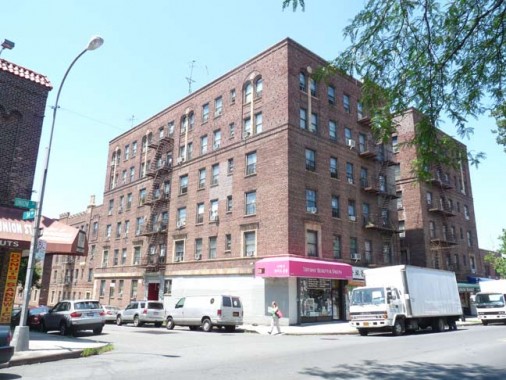
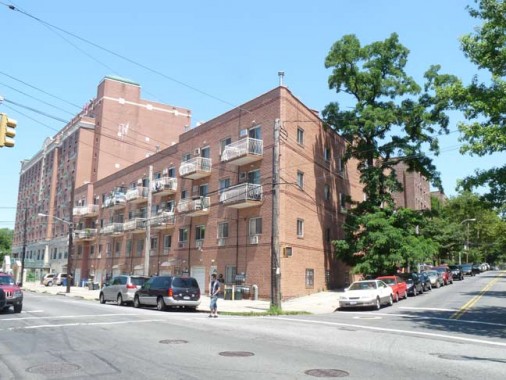
A pair of multifamily buildings face off across Union Street at 34th Avenue. Above is the older vision with decorative terra cotta elements, handsome brickwork, and storefronts facing the street. Below is the new vision, with garages facing the sidewalk, rusting fire escapes, and garbage collection by the front entrances.

Union Avenue is encrusted, barnacle-like, with the machinery and signage of earlier decades. This FDNY alarm sports its original pull handle it had when installed decades ago, and is accompanied by the placebo of a push-button, which fools the pedestrian into believing they can change the stoplight to green at their convenience.
Do they work at all?
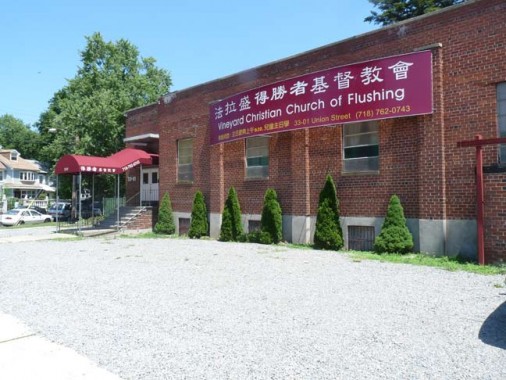
At 33rd Avenue, the Vineyard Christian Church has a gravel surface parking lot all its own.
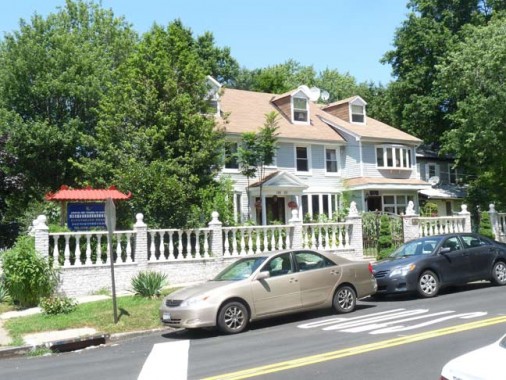
Why modern homeowners are obsessed with fence columns like this escapes me. Perhaps they are told they are popular, and they should buy them (just as kids are told that current pop music acts are selling like crazy — so they buy them like sheep, without even caring how they sound). The building houses practitioners of acupuncture and herbal medicine, so you’d think they’d want something more natural looking.
But so much of modern living is making people think you’ve spent a lot of $$$ on yourself.
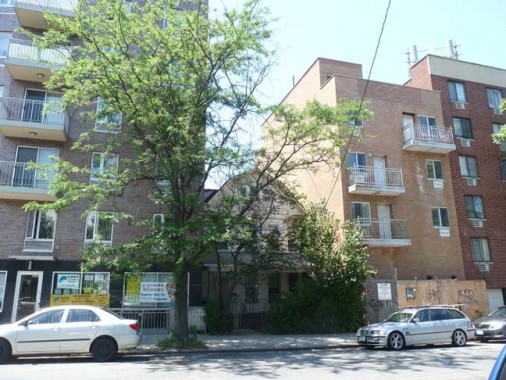
Feeling a little restricted or hemmed-in lately? The folks in the middle know how you feel. Between 32nd and 33rd Avenues.

A large, rather anonymous, multifamily object, NW corner 32nd Avenue and Union Street.

Another of Flushing’s local churches, Pure Presbyterian, 32nd and Union, offers English services as part of its Crossroad International English Ministry.
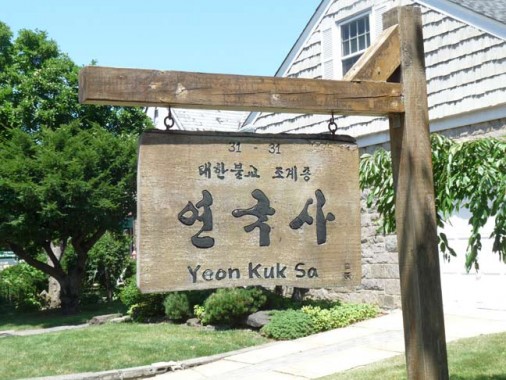
I liked this wood sign on the NE corner at 32nd Avenue. Translation, anybody?
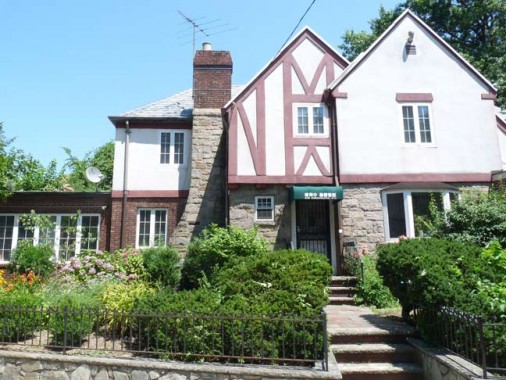
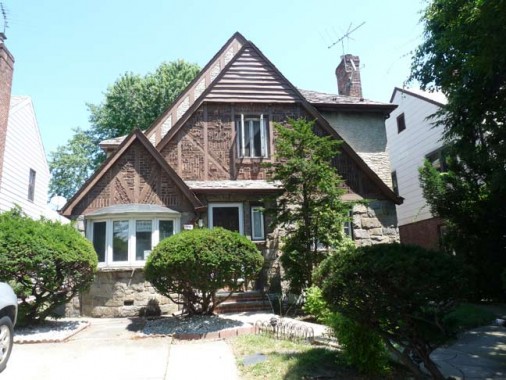
Above 32nd Avenue, the uglier new construction leaves off and some older buildings, like this pair of Tudors, begin to reappear.
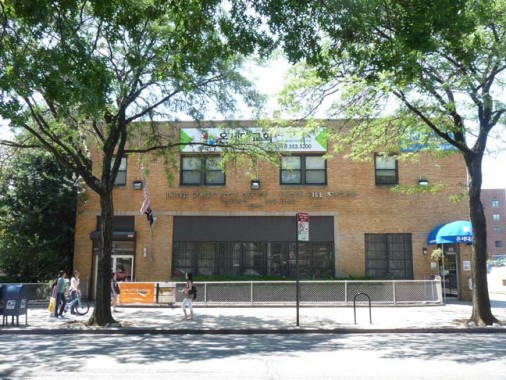
Linden Hill Post Office. Officially, the area between Flushing and Whitestone is named Linden Hill, presumably for local trees found when it was settled, and a main north-south route is called Linden Place.
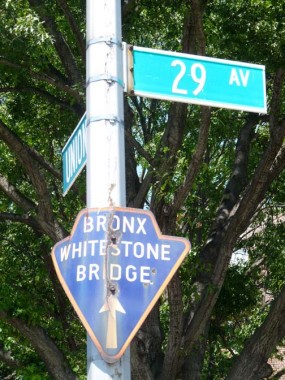
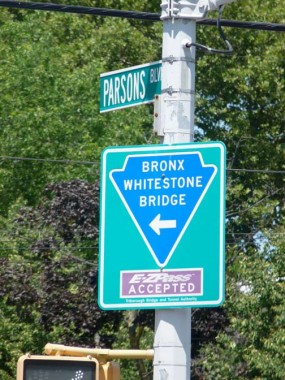
An old-style arrowhead sign pointing to the Whitestone Bridge survives, battered, bruised and unbowed, at 29th Avenue. New versions of these classics have begun to appear, but they aren’t die-cut but merely painted on the standard rectanagular-shaped signs.
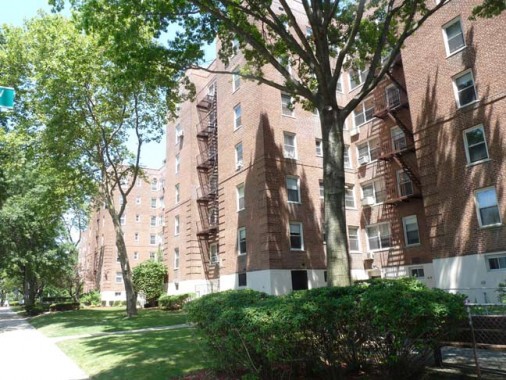
A pair of large co-operative developments, Linden Hill Houses and Mitchell Gardens, face off on Union Street between 25th and 31st Roads. An E.E. Mitchell held a vast area of property in the area and 33rd Avenue was formerly known as Mitchell Avenue.
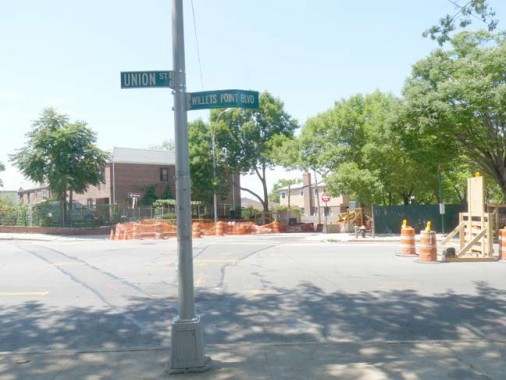
Finally, Union Street makes a bend at 143rd Street and metamorphoses into Willets Point Boulevard.
Willets Point is actually located within Fort Totten on the north shore, though many now believe it is in eastern Corona because of the persistence of the Metropolitan Transit Authority, which resolutely drops the “Boulevard” at its Willets Point–New York Mets station. A short piece of Willets Point Boulevard beneath the station is the main drag of the Iron Triangle, a concentration of auto body and hubcap shops the city is attempting to evict, as its esthetics displease Mayor Bloomberg and the NY Mets owners.
Oddly, the two pieces of Willets Point Boulevard are now over a mile apart, though they may have been connected before the Whitestone Expressway, né Parkway was built in the 1930s.
7/29/12

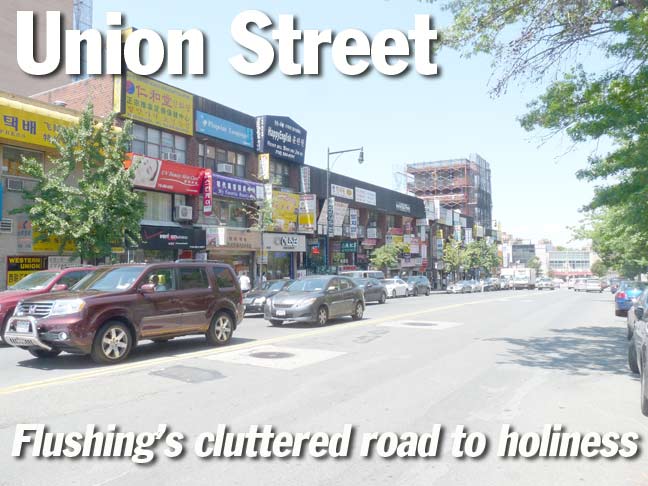
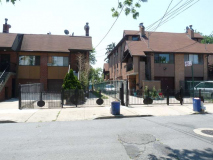
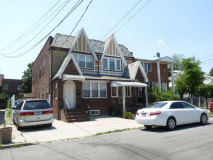
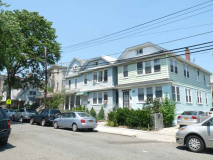
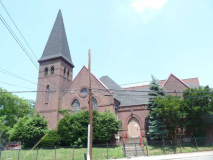
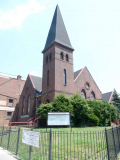
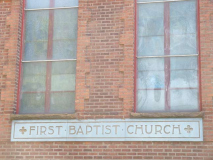
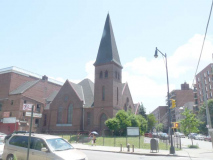
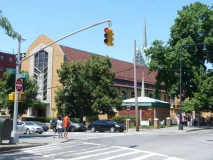
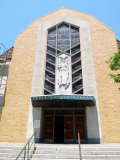

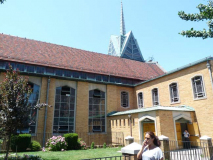
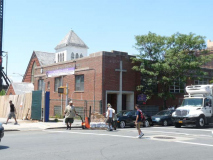
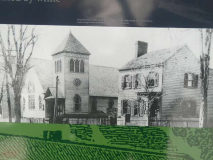
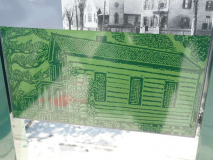
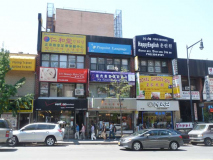
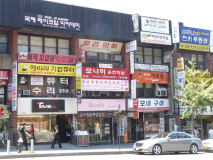
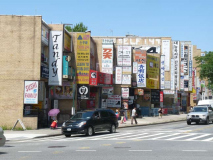

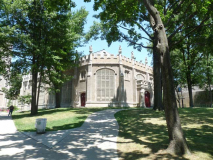
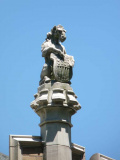
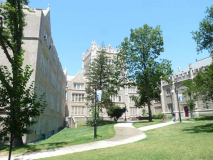
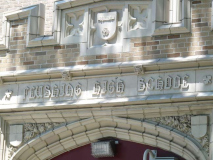
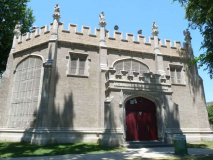
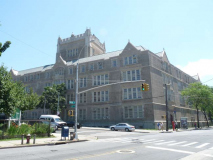
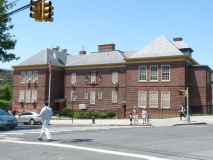
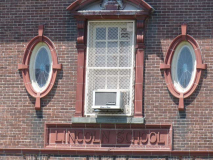
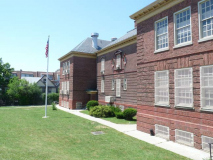
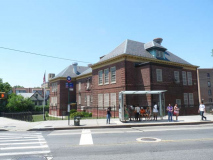
41 comments
I grew up in a different part of Queens, but I have been to this area millions of times. For shopping and visits to friends houses. Remember Korvettes, I used to get a lot of albums there for like $3.99! LOL!
In the next to last paragraph on this page, you refer to NYC as trying to “convict” the denizens of the Iron Triangle. I assume you meant to type “evict”? Although, I am sure if Mayor Bloomberg could convict them of something, he would; it would hasten the eviction….
Freudian? fixed.
It’s been said that a grand jury could indict a ham sandwich; so, fabricating some contrivance to hasten the eviction of the guys there isn’t far fetched. I used to get my repair parts from there., from window crank knobs to complete front ends. Ah, the good old days……
Heh. I attended Flushing High in the ’60s; I had no idea of the building’s history, and I called all those things “gargoyles.”
I’m glad it’s been saved.
The Vineyard Christian Church is a former Orthodox synagogue called Bnei Avraham, it operated until around 2000.
The other languages on the First Baptist Church signs are Spanish and I think Hindi.
Finally, Union Street gets respect. :~)
My brother graduated from Flushing HS around 1961 or so. The ceremony was in the RKO Keith’s. I went to Bowne (class of 72), and when we played Flushing in baseball we played on the Memorial Field lot.
Those who remember Memorial Field may recall that it had a large concrete grandstand along 149th Street that afforded ample seating for attendees During a renovation of the facility a few years ago the stands were demolished and not replaced.
In the very early 1960’s the City decided that Union Street from Northern Boulevard to Roosevelt Avenue needed to be widened. This would allow easier access to the large municipal parking lot that surrounded the Macadonia AME Church and made it easier for the bus drivers that had to negotiate the turn from northbound Union Street onto westbound Roosevelt Avenue. All the buildings on the west side of Union were either demolished or cut back. I remember coming out of Robert Hall (on the NE corner) with my mother and refusing to move along because I wanted to stay and watch as part of the McCrotty Chevrolet showroom across the street on the opposite corner was pulled down. Mom was patient for a while, but only for a while and we moved along. A reminder of that Chevrolet agency can be found in an ad for the 1957 Chevrolet that is painted on the side of a building north of Northern Boulevard that can be seen when crossing over the Flushing River coming from Corona into Flushing.
We lived across from McCrotty’s and spent many hours watching the men unload the new cars. There were about 4 old houses on that side, then a brick multi dwelling, then a store front on the corner at 37 ave right across from the Washington School – which was used as a book depot.( now 109 Precinct). 37 Ave was originally Washington Street.
I lived across from the Chevy dealer from 1954 to 1965 36-39 Union St. mid block
Somewhere in the vicinity of Union and Sanford was an American Red Cross office back in the 60s. I worked as a Red Cross volunteer during the summer in high school (attended Forest Hills High).
Nancy Reagan may have lived in Flushing but she was born in Manhattan. I lived in Middle Village but was born there too.
http://en.wikipedia.org/wiki/Sloane_Hospital_for_Women
Take another look at the 1909 atlas plate where Union Street crosses over and becomes Whitestone Avenue. It is also where the current Northern Boulevard was Broadway to the east and Bridge Street to the west. If you follow Bridge Street two blocks west you will find a building labeled “Magistrates Court” on the corner of Linden. That is the former Flushing Town Hall being re-purposed by the newly enlargened City of New York following the consolidation. As pointed out on a previous FNY page, it has survived and flourished, being once again re-purposed, this time as a cultural center.
Haiku? Surely you mean Hangul!
Thanks for a walk down near where I grew up. I attended P.S. 214Q (Cadwalder Colden School), at the corner of Union St and 31st Rd, across from the Linden Hill Post Office. The “stuck in the middle” house between 32nd and 33rd Avenues is representative of the houses before the building up of the area from the mid-90s onward. Thanks Sergey Kadinsky for filling in the history of the Vineyard Christian Church, formerly the Bnei Abraham Synagogue. At the Q44/Q14/Q20/Q16 bus stop on the southeast corner of Union St and Bayside Ave used to have some ancient painted bus maps/diagrams for the Q44, perhaps 5-10 years ago when I last remember checking closely
I lived on Union Street between Northern and 37 Ave from 1953- 1964. Your site brought back many memories. I remember the parking lot being built. It replaced a City housing project on Union as well as private homes on 37th and 38th. The Wiliams family has an oral history on the Internet about the eviction of the black families. The parking lot was closed on Sundays and we roller skated there then. It was a neighborhood of private homes built about 1900, mostly Gerrman and Irish families. The Dowling family still lived there having owned a lot of Union Street along with the Piper family from 37 Ave. Do you remember Lubsom’s that became Jones and Allen? Do you’ remember Rubens candy store? The same cop directed traffic at Roosevelt Ave every day as we walked to St Michael’s school. The firemen would let us slide on their pole on the way home from school. Anyone remember Father Gus who lived on 38 Ave? Flushing was beautiful then, old homes, big trees, and a safe place for kids.
Eileen, this area is very familiar to me. I lived in the Bayside/Whitestone area. The Q16 route included Union Street and Bayside Avenue. There was a Dutch homestead (large parcel of land compared with the newer homes in the area). It had a large home that looked very old, but it was well-maintained. In the ’60s, this property was put up for sale. I visited it with a real estate agent who worked in my building, so curious was I to see the inside. It was magnificent. I’m thinking this land and house was part of a large parcel at one time when the Dutch were prominent in Flushing…long, long time ago.
Do you remember this piece of Flushing on the corner of Union Street and Bayside Avenue?
The purchaser of the property tore down the house and erected a multilevel apartment building. It was so sad to see this historical piece of Flushing disappear.
Hi Eileen. Dowling family was my fathers relatives. If you have more info or would like to correspond please email me. Jeanwhitlinger1@gmail.com
My husbands aunt Mary dowling lived many yrs on Union st .Her family owned lots of property inFlushing including the sight where Robert Halls was.Her family was one of the first families in Flushing and were in the butcher business.Betty Dowling
I grew up in the Linden Hill neighborhood (right behind the Post Office) in Embassy Arms on 31st Rd just west of Union Street between 1960-1972. I attended Cadwallder Colden Elementary School (PS 214). Back then the neighborhood was primarily Eastern-European Jewish and Italian with a smattering of German and Irish. It was a beautiful neighborhood with wide tree lined streets and manicured cooperative apartment developments (Embassy Arms, Mitchell Gardens, Linden Hill and Linden Towers), and beautiful single family and some two family homes. It breaks my heart to see the upzoning that New York City allowed on Union Street and it’s environs, which have changed it’s character from a once surburban neighborhood to an overdeveloped, overpopulated neighborhood destroying the former small town character and charm of old Flushing. (P.S. Willets Point Boulevard in the “Iron Triangle” and Willets Point Boulevard in Linden Hill/Whitestone area were never connected. It was a “paper road” that was never constructed, and the Whitestone Expressway (formerly Parkway) provided the link along almost the exact “planned route” of what would have connected the two stubs of Willets Point Boulevard.
The missing languages are hindi in the top right, and either arabic or perhaps farsi (persian)
Union Street was my hangout from 1971 to 1973. My friends and I spent many an exciting evening over by the park near the school and patronizing the stores by Mitchell Gardens. Now I can barely recognize the place. At that time, Congressman Rosenthal proved a godsend to my mother expediting immigration matters. She found his staff to be genuine human beings and highly efficient, and spoke of them long after his passing. I also spent a few nights over at Adventurers Inn. In many ways, those were the best days of my life! Thank you so much for posting.
Directions to another hidden gem along Union St. Stand on the SE corner of Barclay
and Union and walk about 50 yards East, up Barclay until you get to the entrance of the
schoolyard of P.S. 20 turn right and walk about 30yards along the edge of the bldg.
and look down. You will see thereabouts a roughly four foot square sandstone block
with the date 1875 embedded in front and 1874 on the side. I am certain that this block
was the original cornerstone of FLUSHING HIGH SCHOOL which was originally
located on that very spot. It should be recognized or at least moved to a more
appropriate place. Check it out.
This is a really good expose on a unique part of Flushing. I’m glad you mentioned the Lincoln School and it would be good know more of its history but you seemed to imply that the Jackson School was closed but it appears in one of the excerpts. What happened to these consortium of schools? This really will advance my work on a proposed history tour of Flushing with a focus on the Remonstrance and the fact that the dedication to Lincoln and Jackson is very important. It really shows how Flushing thrived as a community that reached for the highest ideals of liberty and democracy. The tudor-style homes are a really nice addition. Thanks for taking the time to share this kaleidoscope of Flushing.
I used to live at 46-15 Bowne Street in Flushing and in the late 80’s to mid 90’s the whole demographic view changed literally overnite, not happy since this was a strictly white european nieghborhood and now its all asian.. I miss all my friends that lived in Flushing and Whitestone, hopefully one day they can find a way to reach out to me. Remember guys Saint Micheal’s Grade School in downtown Flushing! Remember the nuns??!!!
Bill Cendales
Nice story and great to tour the old ‘hood. I attended Saint Michael’s school from third through eight grade in the 70’s, went to church at St. John Vianney, played hoops in the IS 214 playground and was sent to the Linden Hill post office by my folks thousands of times!!!
Did you know? – The original SJV church was Singer Hall on 35th Avenue between Leavitt Stand Linden Place (the little white steeple is still there!).
Also give a quick check of the location of P.S. 23 – “NW corner of 25th Avenue and Union Street” –
I believe that should be 35th Avenue.
Once upon a time a Dutch home on a large plot of land stood at the intersection of Union Street and Bayside Avenue. I passed it on the Q16 bus many, many times during my young years. It was magnificent, and it should have been preserved because of its age and heritage. Flushing was founded by the Dutch in the 16 hundreds. I got to visit this house when it went on the market in the 1960s. What a step back in time that experience was. I was so sad to see it torn down to make way for a large apartment building (well, large in those days).
I lived at 27-05 Parsons Blvd until 1966. The picture above actually shows the apt we lived in on the 2nd floor. Another picture shows Lewis Pharmacy on the corner of Union and Roosevelt. I worked there part time from 1965 to 1973.
Many years ago I was in a meeting with Congressman Rosenthal. I think he had an office in the post office on Main St. More recently I was in a meeting with Gary Ackerman. 2 good guys.
I lived on Union St. And 45th av. in the 60’s on the same block where my school PS24 was! It was a great neigborhood, I loved growing up there. I remember the Public library, I believe was on kissena Blvd, Dave’s stationary store, the deli, the parades I used to see on Main St. Etc, many great memories.
I was fascinated by your story of Union Street. I’ve not been a New Yorker for a half century. And never knew Queens. But my Family…I mean starting with my 2nd Great Grandfather, Richard Cornell, a harness maker, had his place there on Union Street. The Census of 1880 didn’t give Street names or addresses, but the next entry on the 1880 Census was an “Infant Asylum” with about 75 or 80 children, most around the age of 1. I couldn’t find mention of that in your article. Does anyone know where it might have been located? That would have been where my great grandfather grew up
I attended Flushing Hing Schoo in 1961 and could have gone to a few reunions ,but had second thoughts and didn`t go simply because I would rather remember the good times the big clock on Main street and Roosevelt Ave. and Glorio`s Pizzeria at that location also, two slices of Pizza and a small coke for 25 cents
why I don`t mind if you do
I was brought up in the second tudor house on union st,,,,,,off 32 ave thank you for bringing back memories for me…..loved the old neighborhood……thanks joe
I lived at 25-40 Union Street, in the Mitchell Gardens co-op complex from when my family moved to the new apartments in 1952, moved away when I married in 1974. My mother stayed untill she needed to be with us in 1998. My best friend, whose family moved in when mine did, still lives there to this day.
Given the alternatives that my parents considered, Mitchell Gardens or another Co-op somewhere on 3rd Avenue in Manhattan, I’m glad they moved here.
The shops on Union Street North of PS214 (if you have the chance, check out the biography of Cadwallder Colden who proposed what would have been the Erie Canal in the 1700’s, short summary from Wikipedia – Cadwallader Colden was a physician, natural scientist, a lieutenant governor and acting Governor for the Province of New York) were originally going to be a duplicate of the coops north of 24th Street. The co-op building in which I resided is notible for the wide semicircular front lawn and its set back from Union Street. Another Co-op building with the same setback and semicircular lawn was originally planned to occupy what became the Diatch-Shopwell grocery store complex. Thanks for the memories.
But you never did ascertain why Union Street was given its name. Or did I miss it?
I lived at the corner of 33 ave & Union street from 54-86. My house is pictured in your article about the columns . I loved every part of this story . Been back many times . Brings back so many memories.
I went to high school att Joseph,snovitiate on the corner of Sanford avenue.it was an annex of the diocesan hs.while there we worked on a centennial celebration of flushing and there was big display at the Bowen house.my wedding reception was at the Sanford hotel in 1954.i lived in the broadway section of flushing 163 st and43 ave.flushing wasagreat place to grow up.
My great grandfather was born on his family’s lot. Old City Directories give the address as 26 Union Street (ca 1880s). He was a harness maker. Any idea where 26 Union Street in the late 1800s would be today?? Would be grateful for any information.
Tom, if I’m interpreting an old map correctly, I would guess that 26 Union Street would be along the eastern side of the street roughly midway between Northern Blvd. and 37th Ave.
The New York Public Library’s website has digital scans of old NYC fire insurance and property maps. Check out the 1903 Sanborn Map Company Insurance Map (Volume 5), specifically “Plate No. 51”
Sadly, the AME Church on Union Street has been razed to make way for multi family housing.